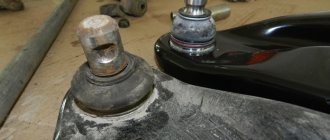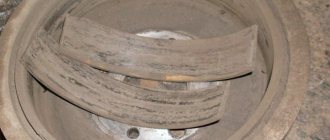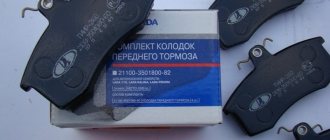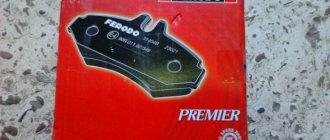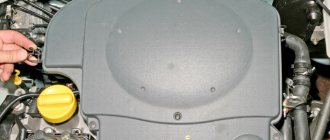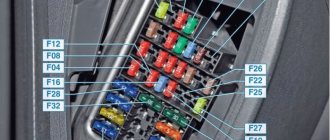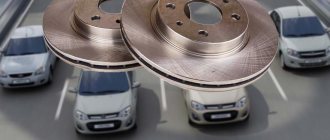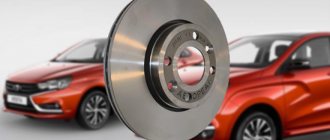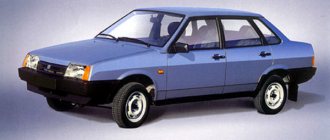I read the above text with hope when purchasing new Markon brake pads. But first things first. After looking at the caliper that I had pads from the 16 valve version, I started searching.
There is a chain of stores “Ferodo” in our glorious city (far from advertising). I called and asked if Ferodo FDB 1617 pads were available. The sound in the handset was wheezing for a couple of minutes, then he answered, “Yes, 870 rubles.”
After work, I happily went to Pokhodnaya to get some wheels, by the way, the wheels are also 16 bug proof, ventilated. I took Fenox wheels.
Then I went to get the pads. The store is located on Okruzhnaya 55. I walked in and said, “I called you on the blocks, FDB 1617.”
This rooster frantically looks at the monitor, then goes somewhere and brings me pads with the words “This is not only Ferodo, but a very good analogue.” I think it’s a miracle... Okay, I think maybe I’ll get lucky. I bought it and went to change it.
I changed the discs and pads, everything fit perfectly. Of course, I was shocked by the discs that were removed. They devoured them during my 40,000 km mileage. vhlam! Below are the photos:
Well, here's a photo of the replaced brake discs and pads:
The replacement was made 3 days ago and today I am writing reviews about these very miracle pads from the company MARKON! Friends, never take these pads under any circumstances! They creak more than the previous TRWs.
In the morning I went to one of the online stores and ordered the same FERODO 1617 without any similar originals.
One of these days I’ll go again to Okruzhnaya (no advertising at all) and throw the removed pads in the face of this fat devil who swore to me about their unsurpassed quality.
Now I’m driving like an old cart, I’m squeaking with marcon and I’m looking forward to the arrival of my normal pads. Next week I’m finally planning to change shoes to R17
Lada Largus cars are in great demand. Driving safety not only in these, but also in cars of other brands is ensured thanks to the braking system. You can extend its service life and the operation of your car by monitoring the condition of the brake system, and in particular the brake discs.
Types and features of Lada Largus brake discs
On the modern market, brake discs for Largus are presented in the following options:
- ordinary cast iron,
- ventilated,
- with perforation.
Conventional brake discs are distinguished by their fairly low price. They are not used in vehicles with high-power powertrains. They are best not used when driving fast due to their inability to cool. They tend to overheat, which makes braking noticeably less effective.
Ventilated discs of Lada Argus are not used on all cars of this model range.
Perforated wheels will appeal to those who have to drive fast or who simply enjoy driving that way. They work great in emergency braking situations. In general, prices for all Lada Largus brake discs are reasonable. Therefore, replacing them will not be too expensive, and the level of driving safety will increase.
How to choose brake discs for Lada Largus?
When there is too much wear on the brake discs on a Lada Largus car, they need to be urgently replaced with new ones. The thickness of their wear can be measured with a ruler or caliper.
When purchasing a suitable brake disc, it is important to remember that cars of this model are equipped with different types of power units. Therefore, the brake system in cars can have a large number of differences.
In this case, you should choose brake discs of different thicknesses.
Paired with a powerful motor there must be a powerful braking system. This should be taken into account when choosing components in the form of brake discs. For power plants with a minimum power level, a front Largus brake disc with a thickness of 10.6 millimeters or 17.7, depending on the type of engine, is suitable.
For more powerful engines, the thickness of the brake discs can reach 20.7 millimeters.
If the thickness of the brake discs is below normal, they should be replaced with new ones.
Replacing brake discs Lada Largus
When you need to replace the front brake discs of a Lada Largus, you can carry out this procedure yourself, or use the help of car service specialists. They have the skills to work in this area, and are guaranteed to do all the work quickly and efficiently. Also, if you have the knowledge and skills, you can do everything yourself.
First you need to remove the wheel by unscrewing all the bolts. It is important to lift the car with a jack. Next, the wheel is removed along with the caliper. Only when these elements are removed can you begin to dismantle the old brake disc and install a new one.
The discs themselves are attached to the hub. The procedure for dismantling it can be carried out by unscrewing all the bolts. This is done using a special tool.
There are situations when the brake disc does not lag behind the hub. In this case, you can use a hammer. Just a little tap on the disc and it will fall off on its own. If you have a metal brush, you should clean the places where the hub attaches to the disk from dirt.
This procedure will not take much time, but will extend the life of the brake system. Also, do not forget about applying a special lubricant that prevents vibrations while the car is moving.
Only when all procedures have been completed can a new brake disc be installed.
A distinctive feature of the Lada Largus is the presence of disc brakes both front and rear. Which makes management more responsive and informative. But it is important to constantly monitor the condition of the brake system. Especially behind the pads and brake discs. The latter should not be less than a certain thickness. Otherwise you need to replace it.
What front brake discs can be installed on Lada Largus
This type of brake has an important advantage - they are more efficient. At the same time, they require constant attention. The pads wear out much faster than on drum brakes. The situation is similar with disks. Replacement is usually required every 60-120 thousand km. It all depends on the quality of the part.
ATTENTION! A completely simple way to reduce fuel consumption has been found! Don't believe me? An auto mechanic with 15 years of experience also didn’t believe it until he tried it. And now he saves 35,000 rubles a year on gasoline! Read more"
They can be divided into two main categories: original and lecterns. The former have better quality and power reserve. The second ones are much cheaper. But in most cases they are of lower quality. You need to make a choice based on your driving style, available budget and other nuances.
Original
Purchasing original brake discs will not cause any problems. But their cost is an order of magnitude higher than their analogues. At the same time, their service life is an order of magnitude longer than their analogues.
Name Article Cost, rubles
| Brake disc Renault-AvtoVAZ | 8201464598 | From 4 thousand rubles for 1 piece. |
Analogs
The Russian market offers an extensive list of different brands that produce brake discs for this car. Moreover, there are both high-quality analogues and various low-grade crafts. The latter should be avoided. They can make unpleasant sounds when braking or simply moving. And even cause an accident.
Another disadvantage of a low-quality analogue is that it may simply not fit in overall dimensions. We'll have to sharpen it, adjust it. Parts from well-established brands do not create such problems. The following are suitable for replacing front discs:
Name Article Cost, rubles
| B.M. | BDV885 | From 1 thousand rubles for 1 piece. |
| Hella | 8DD355109331 | From 2 thousand rubles for 1 piece. |
| MinTex | xmi-mdc-2087 | From 1.5 thousand rubles for 1 piece. |
There are both more expensive and cheaper analogues. It is important to indicate the item number correctly. Since for 8 valves, 16 valves the sizes will be slightly different.
Replacing front brake pads on Lada Largus: photo
The braking system is an integral part of vehicle safety. First of all, this concerns the serviceability of the Lada Largus brake pads. The choice of these products should be approached responsibly, because you cannot skimp on safety.
Front brake pad replacement process
In order to begin the process of replacing the front brake pads, you will need tools, namely: a wheel wrench, keys 13 and 15, as well as pliers.
So, let's get straight to the process:
- First you need to remove the front wheel.
- We recess the working piston of the caliper. This can be done using a flat blade screwdriver.
- On the caliper, it is necessary to loosen the fastenings of the guide pin from below.
Fastening pin - We remove the finger by unscrewing it.
- Lift the caliper up and disconnect it from the disc.
Without caliper and pads - First we remove the outer block, and then the inner one.
- Remove the upper and lower caliper springs.
- We install new pads in reverse order.
New pads installed
The process for replacing rear brake pads is similar.
When using the brakes for the first time, you should not apply sharp pressure to them, since until the pads are used, the effectiveness will be minimal. This must be done several times at low speed until the machine stops completely.
The replacement procedure with and without the ABS function is the same. The only difference is that when replacing, the speed sensor is removed and inserted back.
Causes of malfunction
The reasons why it is necessary to change the front brake pads are:
- Degree of wear. The service manual states that the products must be replaced when the thickness of the friction part is less than 2 mm. But, as practice shows, the majority of motorists begin to change them when the wear level reaches 1.5 mm.
Comparison of the thickness of old and new brake pads - Broken pad. At the same time, a sound is created, as if something got into the block and is interfering. This malfunction occurs when the quality of the product is poor.
The pad is critically worn, it begins to “eat” the disc - Another indication that the pads need to be replaced is a squealing sound from the front of the wheels when braking . This is a critical level of wear.
All these indicators contribute to the fact that the front pads require replacement. Failure to change this important part promptly will result in loss of brakes or wear on the brake rotors.
Selection of front brake pads for Lada Largus
One of the most popular brands on the brake pad market is FERODO.
Lada Largus can be equipped with two types of front brake pads: with and without ABS function.
They have different catalog numbers, so they need to be considered separately.
With ABS
The first ones have the ABS function. There are quite a lot of pads, from low quality to high quality. But we will only consider those that are recommended to be installed on a car.
Manufacturer's name Catalog number Average price in rubles in the Russian Federation
| Master-sport | 13-0460-2834-2-N-SET-MS | 800 |
| Kraft Automotive | 6005000 | 900 |
| Optimal | 10342 | 900 |
| ABS | 36881 | 1050 |
| Klaxcar France | 24633Z | 1050 |
| Toko cars | CE1-700TOKO | 1050 |
| Bosch | 0 986 467 720 | 1200 |
| Mapco | 6377 | 1200 |
| TRW | GDB 400 | 1400 |
| Febi | 16191 | 1400 |
| Valeo | 301 002 | 1500 |
| Otto Zimmermann | 21463.180.2 | 1500 |
| Febest | 2401-LOGF | 1800 |
| Brembo | P 68 008 | 1800 |
| Fenox | BP43002 | 1800 |
| Automotor France | ABP5071 | 2100 |
| FiT | FP3350E | 2100 |
| Cross | KL05-00162 | 2300 |
| Finwhale | V706 | 2400 |
| Ferodo | FDB 1781 | 2600 |
| SWAG | 60 91 6191 | 3000 |
Analog manufacturers provide a fairly wide selection of analogue brake pads for Largus, but Brembo, Fenox, FIT and Bosch deserve special attention in terms of quality.
Without ABS
The second version of the pads is produced for cars that do not have ABS function. 410608481R is the original catalog number of this product. The average market price in the Russian Federation is 3,000 rubles.
Let's consider what analogues can be installed instead of the original.
Manufacturer's name Catalog number Average price in rubles in the Russian Federation
| Japan Parts | PA-013AF | 1200 |
| ABS | 37395 | 1200 |
| Starline | BD S331 | 1200 |
| Optimal | 12131 | 1300 |
| Profit | 5000-1617 | 1300 |
| Master-sport | 13-0460-2709-2-N-SET-MS | 1500 |
| Klaxcar France | 24996Z | 1500 |
| Febest | 2401-CLIF | 1500 |
| Pilenga | FD-P 8010 | 1700 |
| Delphi | LP1865 | 1800 |
| TRW | GDB 3332S | 1900 |
| Fenox | BP43018 | 1900 |
| Ferodo | FDB 1617 | 2000 |
| Bosch | 0 986 424 795 | 2100 |
| Delphi | LP1865 | 2100 |
| TRW | GDB 3332S | 2200 |
| Valeo | 301 641 | 2300 |
| Brembo | P 68 033 | 2300 |
| Otto Zimmermann | 23973.175.1 | 2400 |
| FiT | FP1491 | 2600 |
| Automotor France | ABP3332 | 2800 |
As in the first case, analog manufacturers produce a fairly large assortment of brake pads for Largus.
Recommendations and improvements
Some car enthusiasts, in order to improve the use of brake pads, replace calipers and discs with a tuning version. They are more efficient than factory ones. Some modifications may require replacing the hub, since the bolt pattern of the parts may vary.
Since the front brake pads last for a maximum of 20,000 km, some owners are not happy with this.
Brembo extended life front brake pads
Instead of standard pads, you can install a sports kit from Brembo, which costs 1.5 times more, but also has a service life of about 40 thousand km, depending on driving style.
conclusions
The process of replacing brake pads on a Lada Largus is quite simple and does not require any special skills. It is worth paying special attention to the selection of spare parts; the better quality they are, the greater the efficiency.
Source: https://carfrance.ru/zamena-perednix-tormoznyx-kolodok-na-lada-largus-svoimi-rukami-artikuly-s-abs-i-bez/
Procedure
- First, we purchase suitable pads. The set of front consumables consists of 4 pieces (2 pieces on each side).
- We control the brake circuit fluid level in the corresponding reservoir (under the hood) using the marks on its body. If the level reaches the maximum level, then it will need to be taken with a syringe, since after installing the new pads there will be a natural (due to the greater thickness of the pads) rise.
- We loosen the tightening torques of the bolts of the front wheel from which the replacement is supposed to begin.
- We hang this part of the car with any available device designed for this purpose. We remove the wheel. Don't forget about safety supports (if a jack is used).
- We take a screwdriver, which we insert between the pad and the disc, and with a pressing force we move it towards the cylinder. The rod is hidden in the cylinder, which provides free space for removing the pads.
- Now we loosen the tightening torque of the caliper bracket, and then move it up.
- We remove the old pads.
- We inspect the springs of the clamping mechanism for their deformation and breakage. If this fact is obvious, then we change it.
- We check the integrity of the rubber covers on the caliper guides. We lubricate the guides themselves with a special compound. This will prevent them from souring, and the bracket will move freely during the exit or entry of the piston.
- We carefully clean the seats for new pads.
- The linings on “fresh” pads are thicker than on old products, so the piston must be recessed to the full extent of its stroke. This will provide enough space for the correct installation of consumables.
- After installation, perform the assembly process in reverse order.
Replacement of front brake pads is completed.
We repeat the entire list of these manipulations on the other side of the LADA Largus.
If there is a need to replace the rear pads, then the principle of operation is similar, with the exception of some nuances.
What kind of brake discs are on Largus?
LADA "LARGUS" is a joint project of the Volzhsky Automobile Plant and the Renault-Nissan concern, which consists of assembling, on the basis of domestic production, a Dacia Logan MCV model car, fully adapted for the Russian market.
Serial production of the LADA Largus began in 2012, presenting three body styles: a passenger station wagon with 5 seats, an enlarged station wagon with 7 seats, and a cargo van.
The initial localization of production was 50%, currently this figure has been increased to 70%.
Since the well-known tested model was chosen as the prototype, the LADA Largus is free of design flaws, but the build quality is still a floating value.
Currently, the greatest demand among owners of this car is for various consumables used in maintenance and repairs. Shock absorbers and other parts of the vehicle's suspension are also popular, which is more likely due to the peculiarities of Russian roads, rather than to design flaws.
Lada Largus cars are in great demand. Driving safety not only in these, but also in cars of other brands is ensured thanks to the braking system. You can extend its service life and the operation of your car by monitoring the condition of the brake system, and in particular the brake discs.
Types and features of Lada Largus brake discs
On the modern market, brake discs for Largus are presented in the following options:
- ordinary cast iron,
- ventilated,
- with perforation.
Conventional brake discs are distinguished by their fairly low price. They are not used in vehicles with high-power powertrains. They are best not used when driving fast due to their inability to cool. They tend to overheat, which makes braking noticeably less effective.
Ventilated discs of Lada Argus are not used on all cars of this model range.
Perforated wheels will appeal to those who have to drive fast or who simply enjoy driving that way. They work great in emergency braking situations. In general, prices for all Lada Largus brake discs are reasonable. Therefore, replacing them will not be too expensive, and the level of driving safety will increase.
How to choose brake discs for Lada Largus?
When there is too much wear on the brake discs on a Lada Largus car, they need to be urgently replaced with new ones. The thickness of their wear can be measured with a ruler or caliper.
When purchasing a suitable brake disc, it is important to remember that cars of this model are equipped with different types of power units. Therefore, the brake system in cars can have a large number of differences.
In this case, you should choose brake discs of different thicknesses.
Paired with a powerful motor there must be a powerful braking system. This should be taken into account when choosing components in the form of brake discs. For power plants with a minimum power level, a front Largus brake disc with a thickness of 10.6 millimeters or 17.7, depending on the type of engine, is suitable.
For more powerful engines, the thickness of the brake discs can reach 20.7 millimeters.
If the thickness of the brake discs is below normal, they should be replaced with new ones.
Replacing brake discs Lada Largus
When you need to replace the front brake discs of a Lada Largus, you can carry out this procedure yourself, or use the help of car service specialists. They have the skills to work in this area, and are guaranteed to do all the work quickly and efficiently. Also, if you have the knowledge and skills, you can do everything yourself.
First you need to remove the wheel by unscrewing all the bolts. It is important to lift the car with a jack. Next, the wheel is removed along with the caliper. Only when these elements are removed can you begin to dismantle the old brake disc and install a new one.
The discs themselves are attached to the hub. The procedure for dismantling it can be carried out by unscrewing all the bolts. This is done using a special tool.
There are situations when the brake disc does not lag behind the hub. In this case, you can use a hammer. Just a little tap on the disc and it will fall off on its own. If you have a metal brush, you should clean the places where the hub attaches to the disk from dirt.
This procedure will not take much time, but will extend the life of the brake system. Also, do not forget about applying a special lubricant that prevents vibrations while the car is moving.
Only when all procedures have been completed can a new brake disc be installed.
Many Largus drivers ask this question, so I decided to make a post. To understand what type of pads you have, just look at the caliper, there are only 2 types. if it is of this type:
There is also another type like this:
Source: https://nadouchest.ru/kakie-tormoznye-diski-stojat-na-larguse/
How to replace front brake discs on Lada Largus?
The service life of the front brake discs on the Lada Largus is not limited by the manufacturer and depends on the driving style of the car owner and the quality of the brake pads used. When the thickness of the discs becomes less than acceptable, they need to be changed.
The minimum permissible disc thickness is 10.6 mm for cars with an 8-valve K7M engine and 17.7 mm for cars with a 16-valve K4M engine. Main symptoms of wear:
increased lateral runout of the disc, vibration during movement and during braking.
Also, discs must be replaced if there are scuffs, deep scratches and other defects on the working surface that increase pad wear and reduce braking efficiency.
If a disk with mechanical defects has a thickness sufficient for operation, then it can be turned and ground on both sides to the same depth in specialized workshops. To work, you will need a standard set of car enthusiast tools, a T40 TORX wrench, a jack, and copper or aluminum lubricant.
When replacing brake rotors, be sure to replace the front brake pads with a new set. After replacement, it is necessary to allow the pads and disc to rub in to the maximum area of contact between the surfaces. Therefore, during the first 100~200 km after replacement, you must be careful when driving due to the increased braking distance.
I figuratively made a review on replacing disks. I couldn’t film it in detail and tell you about it)) Don’t forget to bleed the brakes by pressing the brake pedal several times.
I was about to change the brake discs + pads on the RENAULT LOGAN faza 1, so I assembled a kit. Then I will publish a continuation about the replacement.
Source: https://autotube.video/kak-zamenit-tormoznye-diski-na-lade-largus.html
Signs of pad wear
The instruction manual for a Lada Lagrus with a 16-valve engine, as a rule, contains very detailed information regarding this issue. It also displays all the parameters that characterize the front brake pads. The degree of wear of these consumable components is determined by the residual thickness of the friction linings, which come into direct contact with the discs or drums during braking.
In this regard, gradual and natural abrasion occurs. Many experts are inclined to believe that front brake pads are the most intensively worn consumables. Here you should not wait until the end of the scheduled service life, expressed in mileage (20-30 thousand km), but observe the level of wear with sufficient frequency, and then make a decision on replacement. It is no secret that failed front brake pads provoke increased wear on the working surfaces of discs or drums. Replacing the front brake pads in a Lada Lagrus car is very expensive, so it is not recommended to “bring” the car to this condition.
Some of the most common signs of wear include the following:
- the appearance of a squeak when the brake is activated;
- spontaneous change in direction of movement from a straight trajectory;
- the brake pedal vibrates when pressed;
- it is impossible to lock the wheels with the handbrake, even with the drive cable fully tensioned;
- reducing the thickness of the disc beyond the limit of 21.8 mm;
- the thickness of the friction linings on the pads has approached the critical value of 2 mm;
- the working surface of the pads is dotted with grooves and chips.
Regular inspection followed by replacement of worn-out components allows you to eliminate the manifestation of these factors.
Replacing brake discs on LADA cars
Did you feel vibration when braking? One of the reasons may be uneven wear of the brake discs, which are best replaced in pairs. Discs are also changed when their thickness becomes less than 17.8 mm. Replacing brake discs on all modern Lada cars (XRAY, Vesta, Largus, Granta, Kalina, Priora and Niva 4x4) is performed in the same way without significant differences.
Required:
- new brake discs (Granta, Priora, Kalina): catalog number: 2110-3501070 (13 inches) and 2112-3501070 (14 inches)
- new brake discs (XRAY, Vesta, Largus): 7701206339 (without ABS) and 7701207795 (with ABS).
- set of tools.
Raise the car on a jack and remove the wheel. Unscrew the brake fluid reservoir cap and spread the brake pads, checking the brake fluid level (pump out if necessary). Then:
- remove the brake hose (No. 4) from the strut bracket (No. 5).
- Unscrew the 2 bolts (No. 2) securing the caliper.
Hang the front brake by the suspension spring, preventing the brake hoses from twisting. To remove the brake disc, you will need to unscrew the 2 mounting bolts on the wheel hub, holding the brake disc with your hand from turning. If the brake disc cannot be removed, tap the disc with a hammer on the contact plane of the wheel (hitting the working surface (No. 1) of the disc with a hammer is unacceptable).
Installation of the brake disc is carried out in the reverse order, after first cleaning the adjacent surfaces from dirt. After installation, you must press the brake pedal 2-3 times and check the brake fluid level.
Source: https://xn--80aal0a.xn--80asehdb/do-my-self/repair/repair-lada-vesta/455-zamena-tormoznyh-diskov-lada-kalina-lada-granta-i-lada- priora.html
Useful tips
The first thing that worries every motorist during the next technical inspection of the caliper and brake lining is what its maximum wear margin is. A friction lining thickness of less than 1.5 mm should not be allowed. It is also very important, when changing pads, to also measure the degree of wear of the brake disc.
Lada Largus brake pads can last up to 50 thousand km. mileage during quiet driving. Aggressive driving style greatly reduces the actual life of the product. Therefore, it is better to monitor the degree of their wear every 10-20 thousand km. mileage
It is important to understand which structural elements are responsible for reliable braking. If the car’s braking distance has noticeably increased and obvious signs of a malfunction cannot be determined, the following possible problems can be identified:
- If the wear of the friction linings is within normal limits, but the brakes are working frankly poorly, check the condition of the brake fluid. Perhaps it absorbed too much moisture and lost its performance characteristics;
- if the brake pads are worn unevenly, this is a clear sign of problems with the caliper, in particular, acidification of the guides and working cylinders. It is also necessary to inspect the caliper;
- Excess oil in the caliper guides can get onto the brake disc, which will also increase the distance required to brake the car.
How to choose the right brake system for LADA Largus
Any conscious owner of LADA Largus, who wants to drive without risk to life and with maximum comfort for himself and his passengers, will take seriously the purchase of spare parts for the brake system.
Their functionality and durability directly determine whether the driver will be able to control the movement of the car, park normally and not get into an accident due to problems with braking. The following signs indicate that something is wrong with the brakes and one or another part needs to be replaced:
- extraneous sounds: creaks, squeals and loud noise;
- increasing the duration of the process of stopping the machine;
- untimely operation of the system (wear of the pads or other elements is indicated by both too slow and too fast a reaction).
You should not hesitate to replace individual elements or the entire system, otherwise there is a risk of sudden brake failure while driving. It may also be necessary to change the system as part of a comprehensive tuning, when the driving parameters of the Lada Largus need to be improved.
Selecting brake discs
Most often, motorists need to replace discs that wear out due to frequent or intensive use or due to excessive loading of the car.
Regardless of the cause of the failure, it is important to restore the system to functionality as soon as possible, and for this you need to find disks with optimal characteristics.
Let's see what models for LADA Largus are currently on the market:
- perforated - ideal for connoisseurs of fast driving, they are characterized by fast response, but are somewhat more expensive than usual (but they last longer!);
- ordinary ones - they attract with an affordable price, but are not suitable for variations with powerful motors. They tend to quickly overheat and reduce the effectiveness of the brakes;
- with ventilation is a good option, but such wheels are not suitable for all models in this series (you can check by studying the registration certificate of the car).
Additional items
Considering the importance of the function of the braking system, the selection of each of its parts must be taken very carefully. In particular, no cylinder will function properly if its hose is leaking. In addition, high-quality pads are a must.
To make your car safe and well-driving, it is better to use original spare parts - they can be easily purchased online, for example, in a specialized store https://www.auto-tech.ru/. Among the things you will definitely need to buy, it is worth noting the parking brake cable, brake reservoir and brake booster, hoses and tubes, as well as repair kits for ABS calipers. Select a specific variation depending on the modification of the car and taking into account the manufacturer’s recommendations.
Source: https://autolynch.ru/lada/kak-pravilno-podobrat-tormoznuyu-sistemu-dlya-lada-largus
Procedure
- First, we purchase suitable pads. The set of front consumables consists of 4 pieces (2 pieces on each side).
- We control the brake circuit fluid level in the corresponding reservoir (under the hood) using the marks on its body. If the level reaches the maximum level, then it will need to be taken with a syringe, since after installing the new pads there will be a natural (due to the greater thickness of the pads) rise.
- We loosen the tightening torques of the bolts of the front wheel from which the replacement is supposed to begin.
- We hang this part of the car with any available device designed for this purpose. We remove the wheel. Don't forget about safety supports (if a jack is used).
- We take a screwdriver, which we insert between the pad and the disc, and with a pressing force we move it towards the cylinder. The rod is hidden in the cylinder, which provides free space for removing the pads.
- Now we loosen the tightening torque of the caliper bracket, and then move it up.
- We remove the old pads.
- We inspect the springs of the clamping mechanism for their deformation and breakage. If this fact is obvious, then we change it.
- We check the integrity of the rubber covers on the caliper guides. We lubricate the guides themselves with a special compound. This will prevent them from souring, and the bracket will move freely during the exit or entry of the piston.
- We carefully clean the seats for new pads.
- The linings on “fresh” pads are thicker than on old products, so the piston must be recessed to the full extent of its stroke. This will provide enough space for the correct installation of consumables.
- After installation, perform the assembly process in reverse order.
Replacement of front brake pads is completed.
We repeat the entire list of these manipulations on the other side of the LADA Largus.
If there is a need to replace the rear pads, then the principle of operation is similar, with the exception of some nuances.
